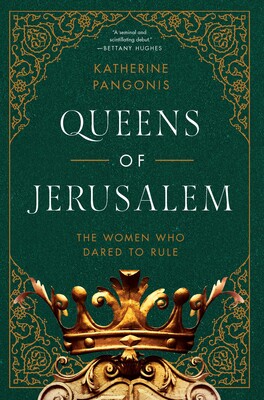Queens of Jerusalem
- By Katherine Pangonis
- Pegasus Books
- 272 pp.
- Reviewed by Allison Thurman
- April 1, 2023
A slim, fascinating chronicle of fearless female monarchs.

Most history I’ve read about the Crusades revolves around the actions of men: the knights who conquered the Holy Land for Christendom, the kings who reigned, and the church fathers who preached the Crusades in the first place. Contemporary historians were men and tended to write about men. When they mentioned women at all, they attributed their achievements to the men around them or maligned them outright.
Katherine Pangonis’ Queens of Jerusalem: The Women Who Dared to Rule, therefore, opened my eyes to the untold stories of powerful noblewomen in the Holy Land during the Crusades.
Pangonis declares in her author’s note that this is a book not only about women and power but about “the forces that limited their power and the power male writers and historians have wielded over their legacies.” While she is careful not to impose modern feminist standards on the past, she illustrates well the contemporary contexts that permitted and limited women’s exercise of power.
Outremer (the various principalities between what is now southern Turkey and northern Egypt) was founded in 1098 AD by conquering Crusaders from Europe. The region remained politically unstable, with constantly shifting alliances between both European and native Christians. The continuous warfare shortened the lives of noblemen, creating both a need and tolerance for women’s leadership. Additionally, Outremer was new enough that personalities informed political loyalties far more than did tradition.
Baldwin II, the third king of Jerusalem and the first to have children, was one such personality. Jerusalem was first among equal principalities but had no male heir; Baldwin II had four daughters. Instead of despairing, he doted on them, grooming his oldest daughter, Melisende, to succeed him. Though he married her to Fulk of Anjou in 1129 for his troops and military experience, Baldwin II’s document of succession decreed that Fulk share power equally with Melisende and their infant son. This act gave credibility to the female line as rulers in their own right.
Not every man agreed, however. Melisende had to fight both her husband and son for her birthright. Her younger sister Alice married into the royal family of Antioch and rebelled twice against her father for rule free of Jerusalem’s oversight. Baldwin II’s youngest daughter, Yvette, found her power in a world of women, becoming abbess of the abbey her sister Melisende founded.
This book focuses on the four princesses of Jerusalem and their descendants, but there are plenty of short sections about other royal women in both Europe and Outremer. Many of these examples illustrate precedents that paved the way for their rule or the ways in which they influenced later queens (Pangonis argues convincingly that Eleanor of Aquitaine’s visit to Melisende’s court during the Second Crusade encouraged her own ambitions).
To be honest, I often found these tangents more interesting than the main history of the queens of Jerusalem because there were so many of them. It made me wonder what else I missed out on in history class!
Queens of Jerusalem is a slim volume and reads easily, but it’s packed with information about many “daring, devious, and devoted” women who grasped for power. Those who won and those who failed are of equal interest to anyone who wants to learn more about the history of the Crusades.
[Editor's note: This review originally ran in 2022.]
Allison Thurman has a longstanding interest in 16th-century history and is currently editing her first novel about the Elizabethan medium Edward Kelley. She lives in Gaithersburg, MD, with too many books and not enough swords.
